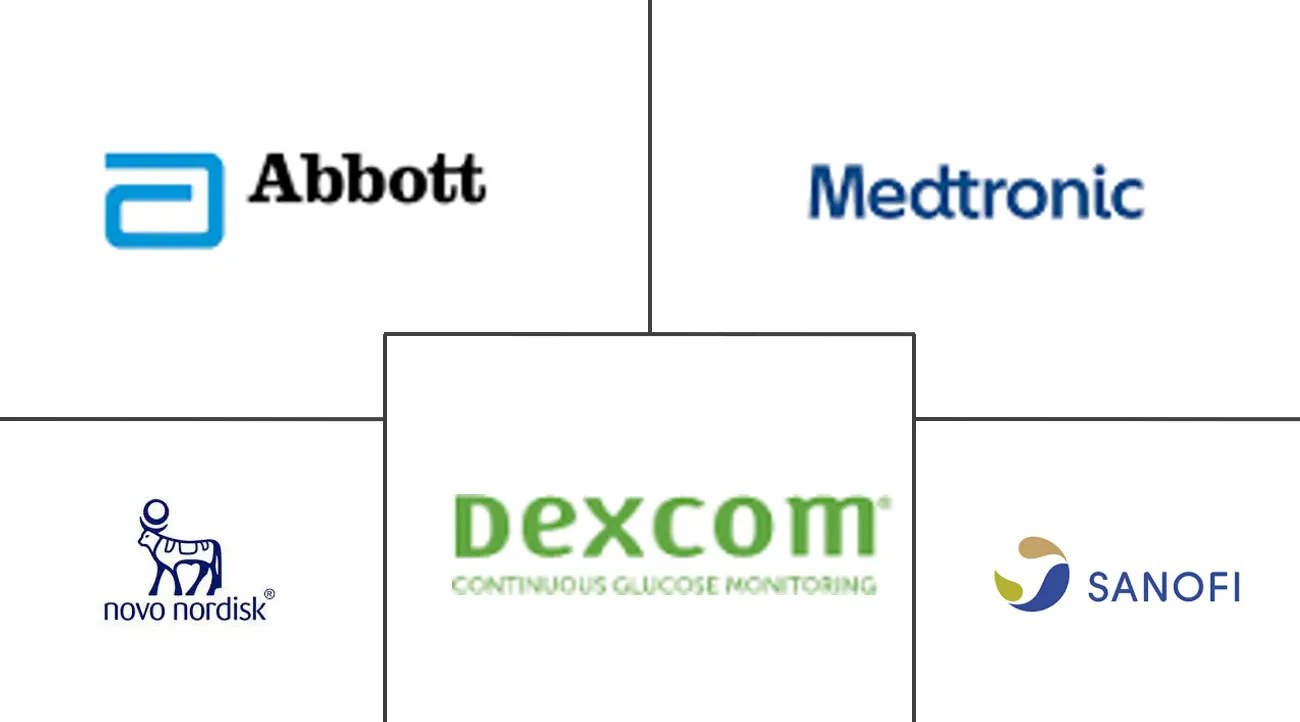New Zealand Diabetes Devices Market Size and Share
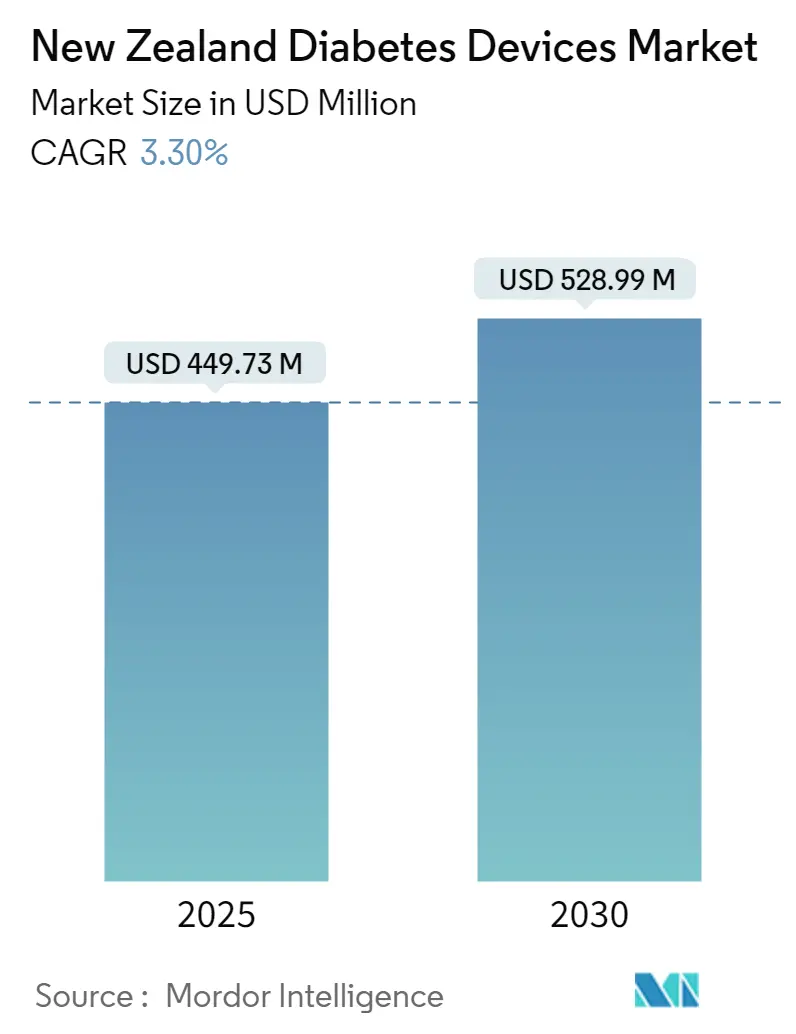
New Zealand Diabetes Devices Market Analysis by Mordor Intelligence
The New Zealand Diabetes Devices Market size is estimated at USD 449.73 million in 2025, and is expected to reach USD 528.99 million by 2030, at a CAGR of 3.3% during the forecast period (2025-2030).
An individual's risk of infection, including other viral infections like the flu, is increased by diabetes. If they get COVID-19, a diabetic patient will likely develop a serious illness and may even pass away. Diabetes type 1 and type 2 patients are at varying levels of risk. Experts generally agree that important parameters like age, additional comorbidities, and diabetes therapy are critical for predicting the possibility of complications. Patients should be aware that if they successfully manage their diabetes, their risk of contracting a severe COVID-19 condition is about the same as that of the general population, as persons with type 1 or type 2 diabetes must concentrate on achieving their objectives during the current pandemic.
Medical devices are important components of type 1 diabetes management. Devices include blood glucose meters, continuous glucose monitors (CGMs), and insulin pumps. These devices have been associated with improved glucose regulation and reduced hypoglycemia. People with diabetes can better manage their insulin supply using user-friendly smartphone software and a reusable injector pen known as a "smart insulin pen." This ingenious system keeps tabs on dosages, computes them, and generates reports, alerts, and reminders-all of which are extremely helpful. They can be reusable device that uses prefilled cartridges rather than vials or single-use pens, or they might be an accessory for your current insulin pen.
New Zealand Diabetes Devices Market Trends and Insights
Rising diabetes prevalence
The diabetes population in New Zealand is expected to register a CAGR greater than 1.9% over the forecast period.
New Zealand is headed straight for the iceberg of expensive medical care. One condition that has grown significantly and is expected to continue to develop is diabetes, which is straining the healthcare system. Gold-standard care will only be accessible to an increasingly small number of people due to a declining workforce supporting an elderly population and a significant rise in the prevalence, with public resources being divided among hundreds of thousands of patients. By 2040, the number of New Zealanders with type-2 diabetes alone is expected to increase by 70-90% to over 400,000 persons.
Patients prefer self-monitoring blood glucose meters over continuous glucose monitors (CGM) because they are more cost-effective and easier to use. While test strips are intended for single use, the average glucose meter efficiency is between six months and three years. Since the market's acceptance rate is anticipated to increase throughout the forecast period, launching new lancet devices that cause less discomfort to consumers will aid market expansion. Companies are being encouraged to create innovative products due to strict government regulations and clear guidelines from the WHO about using diabetes medications and devices to increase patient compliance and reduce diabetic complications.
Owing to the rising prevalence of diabetes and the factors above, the market will likely continue to grow.
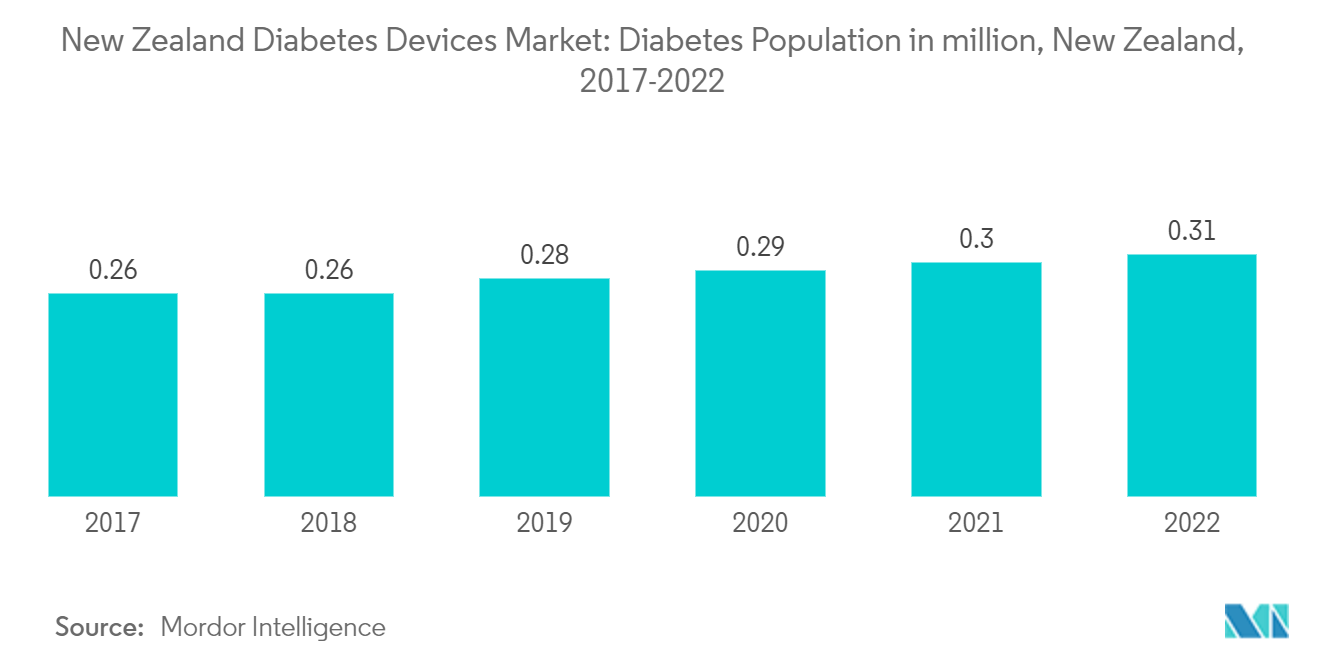
The CGM devices segment Witness Highest Growth Rate Over the Forecast Period
Continuous glucose monitors (CGM) detect the presence of glucose in tissue fluid to measure the body's glucose levels in real-time. A CGM typically provides a fresh glucose level every five minutes, or 288 times each day, unlike a blood glucose meter (BGM), which monitors the blood glucose level at a set time (when you prick your finger).
In New Zealand, medical aid does not cover CGM devices, and public healthcare facilities do not offer many payment choices. People frequently use private organizations like Givealittle to raise money for medical expenses associated with CGM devices required for type -1 diabetes children who require a single device. With CGM devices, diabetic patients in New Zealand pay between USD 4,000 and USD 5,000 each month out of their own pockets.
Diabetes has a significant impact on systemic health costs, but personal health costs are rising more quickly to close the gap. 20% of New Zealand's overall health expenditures is made up of private spending, of which 12-15% is directly out-of-pocket money. Explicit costs are augmented by significant personal loss from lost income resulting from problems that hinder activity and lost non-salary output from the inability to conduct tasks like household chores or volunteer work. The economic cost of lost personal salaries is projected to be $562 million in 2020, rise 47% to $755 million in 2040, and increase from $334 to $506 million in non-salary economic loss during the same time.
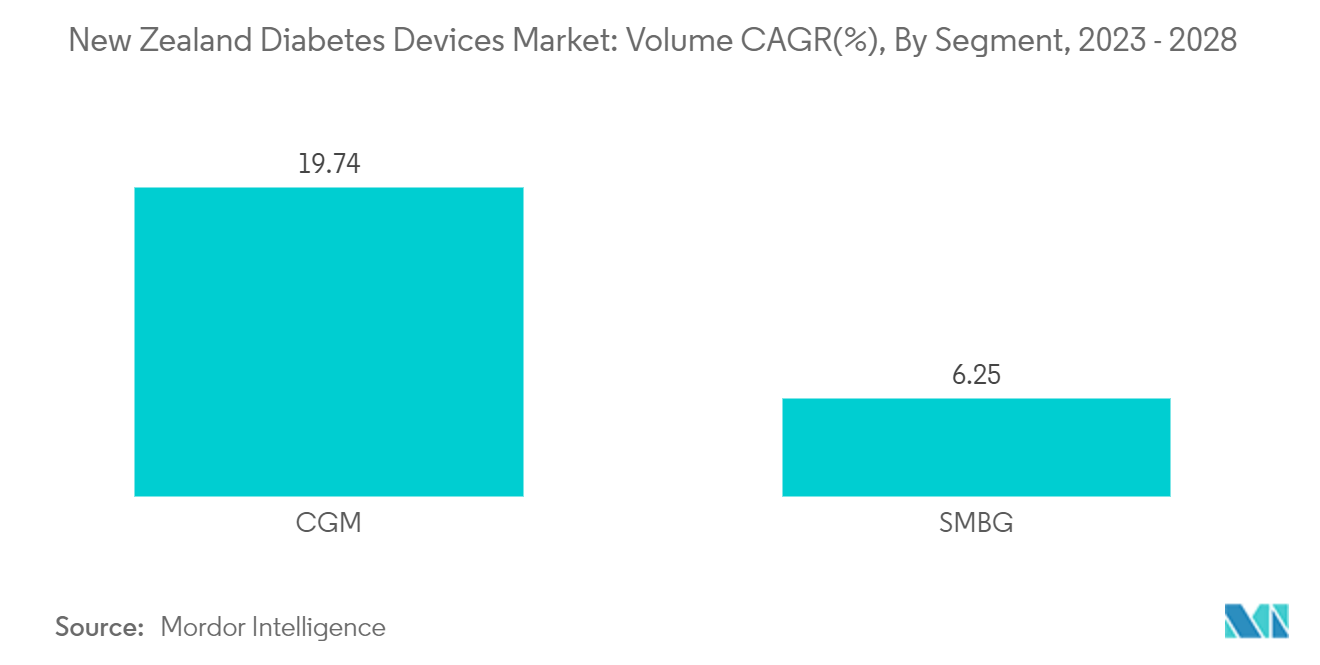
Competitive Landscape
The New Zealand Diabetes Devices Market is highly fragmented with multiple players. Market leaders such as Eli Lilly, Sanofi, Novo Nordisk, and Dexcom are focusing on product launches and technological collaboration to increase their foothold in the market.
New Zealand Diabetes Devices Industry Leaders
Abbott
Dexcom
Medtronic
NovoNordisk
Sanofi
- *Disclaimer: Major Players sorted in no particular order
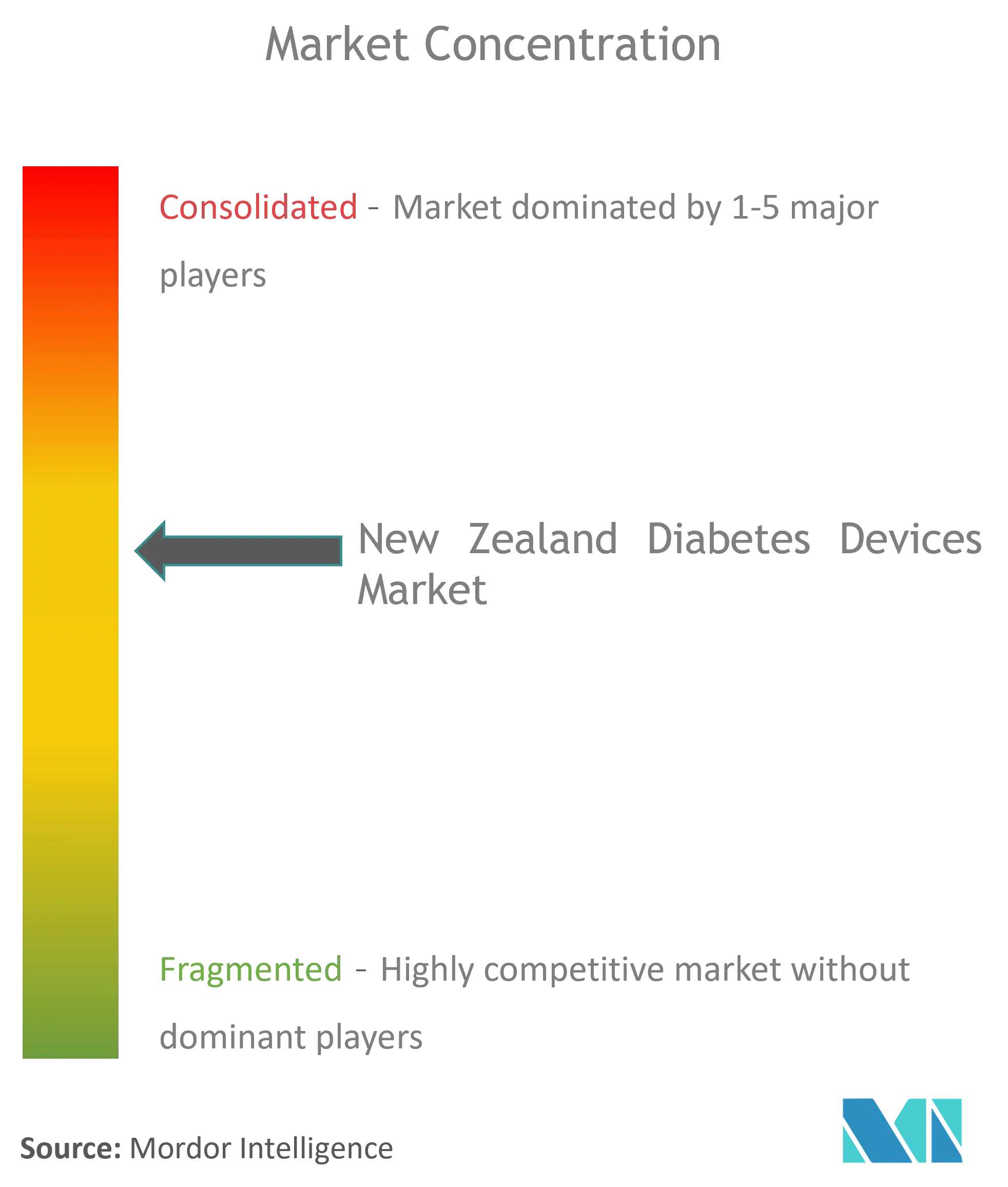
Recent Industry Developments
Jan 2023: Abbott's cutting-edge diabetes technology was approved in New Zealand, costing the same as the original FreeStyle Libre Glucose Monitoring device. To allow users to sleep through the night and be awakened only when necessary, this gadget has optional and programmable alarms that notify them of important glucose levels.
October 2022: Dexcom announced the Dexcom G7 Continuous Glucose Monitoring (CGM) System is now available for people with diabetes aged two years and older. The company is also working quickly to introduce G7 in New Zealand and South Africa in the weeks ahead, with additional markets planned soon after.
New Zealand Diabetes Devices Market Report Scope
Devices are more user-friendly and minimally intrusive, ranging from blood glucose meters and continuous glucose monitoring (CGM) to advanced insulin pumps and more. The New Zealand Diabetes Devices Market is set to witness a CAGR of more than 3% during the forecast period. The New Zealand Diabetes Devices Market is segmented into management devices (Insulin Pumps, Insulin Syringes, Insulin Cartridges, Disposable Pens, and Jet Injectors), monitoring devices (Self-monitoring Blood Glucose and Continuous Glucose Monitoring). The report offers the value (in USD million) and volume (in Units million) for the above segments.
| Self-monitoring Blood Glucose Devices (Value and Volume, 2017 - 2028) | Glucometer Devices |
| Test Strips | |
| Lancets | |
| Continuous Blood Glucose Monitoring (Value and Volume, 2017 - 2028) | Sensors |
| Durables |
| Insulin Pump (Value and Volume, 2017 - 2028) | Insulin Pump Device |
| Insulin Pump Reservoir | |
| Infusion Set | |
| Insulin Syringes (Value and Volume, 2017 - 2028) | |
| Insulin Cartridges (Value and Volume, 2017 - 2028) | |
| Disposable Pens (Value and Volume, 2017 - 2028) |
| Monitoring Devices | Self-monitoring Blood Glucose Devices (Value and Volume, 2017 - 2028) | Glucometer Devices |
| Test Strips | ||
| Lancets | ||
| Continuous Blood Glucose Monitoring (Value and Volume, 2017 - 2028) | Sensors | |
| Durables | ||
| Management Devices | Insulin Pump (Value and Volume, 2017 - 2028) | Insulin Pump Device |
| Insulin Pump Reservoir | ||
| Infusion Set | ||
| Insulin Syringes (Value and Volume, 2017 - 2028) | ||
| Insulin Cartridges (Value and Volume, 2017 - 2028) | ||
| Disposable Pens (Value and Volume, 2017 - 2028) | ||
Key Questions Answered in the Report
How big is the New Zealand Diabetes Devices Market?
The New Zealand Diabetes Devices Market size is expected to reach USD 449.73 million in 2025 and grow at a CAGR of 3.30% to reach USD 528.99 million by 2030.
What is the current New Zealand Diabetes Devices Market size?
In 2025, the New Zealand Diabetes Devices Market size is expected to reach USD 449.73 million.
Who are the key players in New Zealand Diabetes Devices Market?
Abbott, Dexcom, Medtronic, NovoNordisk and Sanofi are the major companies operating in the New Zealand Diabetes Devices Market.
What years does this New Zealand Diabetes Devices Market cover, and what was the market size in 2024?
In 2024, the New Zealand Diabetes Devices Market size was estimated at USD 434.89 million. The report covers the New Zealand Diabetes Devices Market historical market size for years: 2019, 2020, 2021, 2022, 2023 and 2024. The report also forecasts the New Zealand Diabetes Devices Market size for years: 2025, 2026, 2027, 2028, 2029 and 2030.
Page last updated on:
New Zealand Diabetes Devices Market Report
Statistics for the 2025 New Zealand Diabetes Devices market share, size and revenue growth rate, created by Mordor Intelligence™ Industry Reports. New Zealand Diabetes Devices analysis includes a market forecast outlook for 2025 to 2030 and historical overview. Get a sample of this industry analysis as a free report PDF download.
